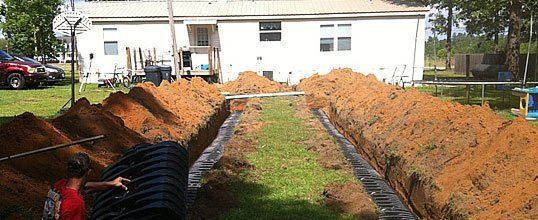Field Lines and Tanks



PROPER MAINTENANCE MAY HELP YOU AVOID COSTLY REPAIRS
Your septic system is designed to receive regular septic maintenance. If you get your septic tank serviced regularly, you may avoid costly repairs.
Billy's Septic proudly uses Infiltrator Materials for Repairs and New Installs. Learn more at http://infiltratorwater.com
WHAT IS A SEPTIC SYSTEM?
Good question! Briefly put, it is onsite waste water treatment systems that processes and purifies household waste (effluent) The effluent consist of black water (toilet waste) and grey water (kitchen, bath, laundry). A septic system has two components: a septic tank and field lines (also referred to as a leach field). Primary treatment occurs in the septic tank where bacteria digest organic materials in the wastewater. The effluent then flows into the field lines for secondary treatment. Here bacteria complete the digestion and purification process as the wastewater slowly leaches or infiltrates into the soil.
THE SEPTIC TANK
The septic tank is a "watertight" underground box, traditionally concrete, about eight feet long, four feet wide, and five feet deep. It has at least a 1,000 gallon capacity. As wastewater flows into the tank, heavy solids settle to the bottom into a sludge layer, while grease and fats float to the top forming a layer of scum. Between these two layers is a clear zone of liquid. Found in all three of these layers are billions of bacteria that live naturally in the tank and perform the first phase of treatment to breakdown the solid matter. As they digest the solid materials gases are produced, which are vented through the plumbing vent on your rooftop.

THE FIELD LINES
From the tank, partially treated effluent flows into the field line system, which typically has two or more trenches. This is where effluent is naturally purified as it percolates down through the soil. The distance between the trenches and the depth to the bottom of the trenches are mandated by your local health department and/or your engineer. This distance and depth is determined by the types of soil present and the water table. Proper testing of the soil, before installing field lines is very important to ensure your system will work properly for as long as possible.
Call us for a
FREE Estimate on Field Lines! Easy Pricing on Tank Pumping! Schedule Today!
251-634-4855
We would welcome the opportunity to earn your trust and deliver you the best service in the industry.

Contact Us Now
Billy's Septic Services
7630 Kushla McLeod Rd
Eight Mile, Alabama 36613
Tel:
251-634-4855
Eight Mile, Alabama 36613
Privacy Policy
| Do Not Share My Information
| Conditions of Use
| Notice and Take Down Policy
| Website Accessibility Policy
© 2025
The content on this website is owned by us and our licensors. Do not copy any content (including images) without our consent.
